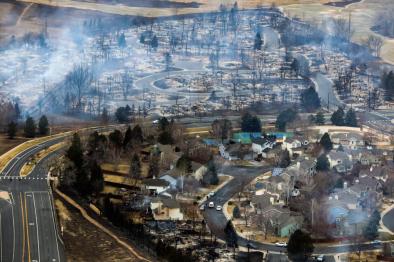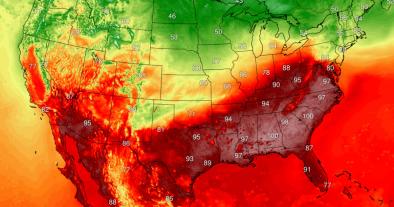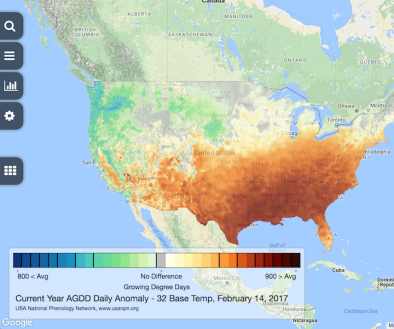


Season Creep
As climate change advances, spring is arriving much sooner, while winters are becoming shorter and milder. Changes in the timing of the seasons has been documented around the world — through studies on plant and animal development and life cycles, temperature and snow cover — and informally dubbed “season creep.” Season creep is an example of how small changes can have a big impact. Climate change disrupts the critically important timing of events, such as snow melt and spring bloom, upon which ecosystems and agricultural industries depend.
Read More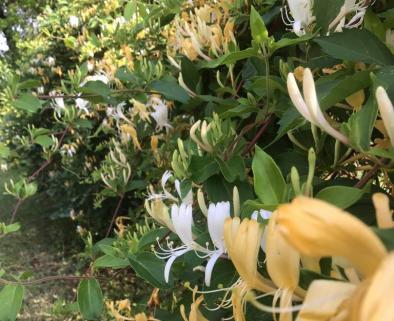
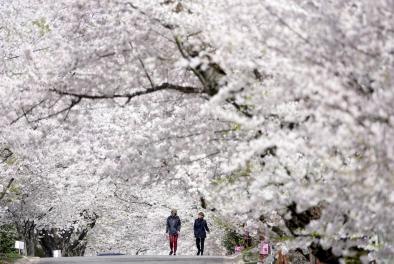
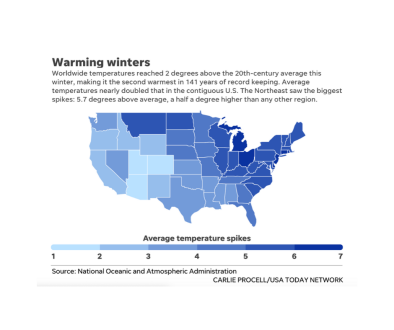
Climate science at a glance
- Shifting seasons are directly linked to warmer global temperatures.
- Shorter, milder winters, earlier springs, and later falls are altering the timing of critical biological events.
- Seasonal shifts have already had an impact on biological systems worldwide.
Background information
What is "phenology"?
The timing of important biological events is known as phenology and is a key indicator of the effects of climate change on ecological communities
How does global warming affect phenology?
Global warming has been linked to changes in phenology including shifts in the timing of allergy seasons, lengthening growing seasons, earlier spring thaws and later first frosts, increases in wildfire activity and pest outbreaks, declines in native species, and the spread of invasive species.
What are frost-free periods and why are they important?
The frost-free period is defined as the period of time between the last spring frost (daily minimum temperature below 32°F) and the first fall frost (occurrence of 32°F).
The timing of last spring frost dates, first fall frost dates, and frost-free period lengths determines the timing of the freeze–thaw process in hydrology, affects the annual life cycles of plants and animals, human food production, and influences land–atmosphere interactions, including the water and carbon cycles.
US season creep trends and climate change
- (NCA 4, 2018): "Across much of the United States, spring is starting earlier in the year relative to 20th-century averages, although in some regions spring onset has been delayed. In marine and freshwater systems, the transition from winter to spring temperatures and the melting of ice are occurring earlier in the spring, with significant impacts on the broader ecosystem."
- (Dave Hollinger, 2017): In the Northeast, the last spring frost is about a week earlier now than it was 30 years ago on average. This leads to increased chances of frost damage since the start of growth for many plants has shifted even earlier than the last frost date.[4]
- (Zhang and Wang, 2016): Drier, warmer autumn weather may be extending summer smog well into the fall in the Southeastern US.[7]
- (McCabe et al., 2015): The number of frost-free days in the coterminous U.S. has increased in recent decades (see image below).
- (Peterson and Abatzoglou, 2014): The continental US experienced widespread earlier green-up (when plants go from winter dormancy to photosynthesis) and last spring freeze dates over the period from 1920 to 2013. From 1950 to 2013, green up and last spring freeze advanced by 4.2 and 7.9 days respectively.[3]
- (Abatzoglou et al. 2014): The date of the first autumn freeze in the Pacific Northwest has been delayed 9 days since 1950.[6]
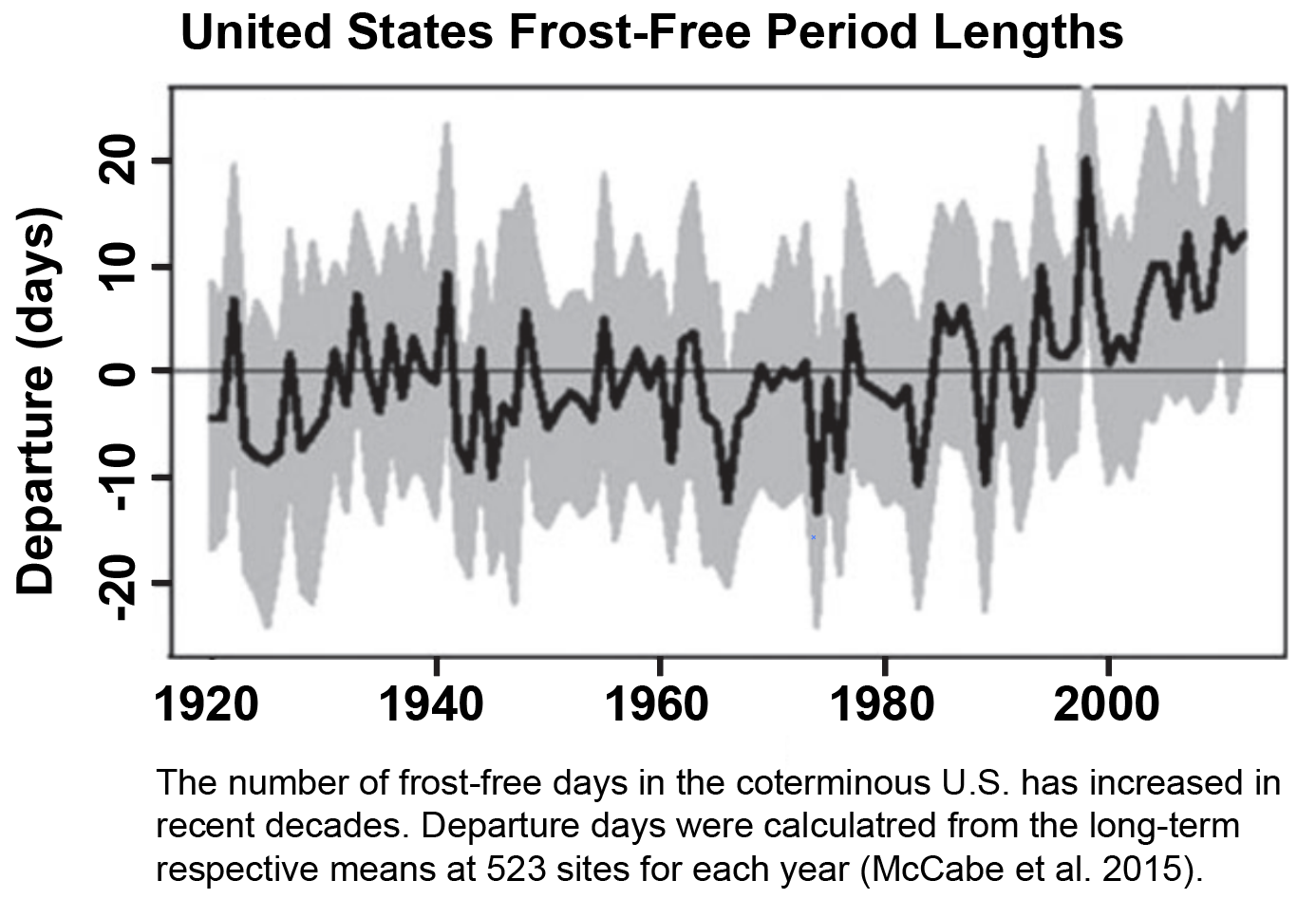
Global season creep trends and climate change
- (IPCC, AR6, 2021): "The growing season has, on average, lengthened by up to two days per decade since the 1950s in the Northern Hemisphere extratropics."
- (Wang et al. 2021): Summer in the Northern Hemisphere midlatitudes has lengthened, whereas winter has shortened, owing to shifts in their onsets and withdrawals, accompanied by shorter spring and autumn.
- (Dunn et al., 2020): Over the Northern Hemisphere as a whole, an increase in the growing season of about two days per decade is evident for 1951–2018.
- (Kukal and Irmak, 2018): Over North America, a rise of about 1.3 growing season days per decade is apparent in the United States for 1900–2014.
- (Barichivich et al., 2013): In Eurasia and North America (above 45°N), the length of time in a calendar year when temperatures are consistently warm enough for agricultural activity lengthened by 10 days between 1982 and 2011. In Eurasia, the growing season increased by 13 days, and in North America, it increased 6 days. The extension of the autumn growing season since 1982 is about half that of the spring extension.The increase closely tracks the pace of warming in the spring.[10]
- (Jeong et al. 2011): In North America, the end of the growing season was delayed by 8.1 days from 1982 to 1999 and delayed by another 1.3 days from 2000 to 2008. Hardwood forests in the Northern Hemisphere are holding their green leaves for over a week longer than normal.[5]
- (Schwartz et al. 2006): Warming of the Northern Hemisphere is well-documented and typically greater in winter and spring than other seasons.[9]
Studies attribute global season creep to climate change
- (IPCC, AR6, 2021): "Northern Hemisphere spring snow cover has decreased since at least 1978 (very high confidence), and there is high confidence that trends in snow cover loss extend back to 1950. It is very likely that human influence contributed to these reductions. Earlier onset of snowmelt has contributed to seasonally dependent changes in streamflow (high confidence)."
- (Ault et al. 2011): Research indicates that natural variability can, at best, explain only one-third of the rate of “creep” in the arrival of spring in North America.[11]

